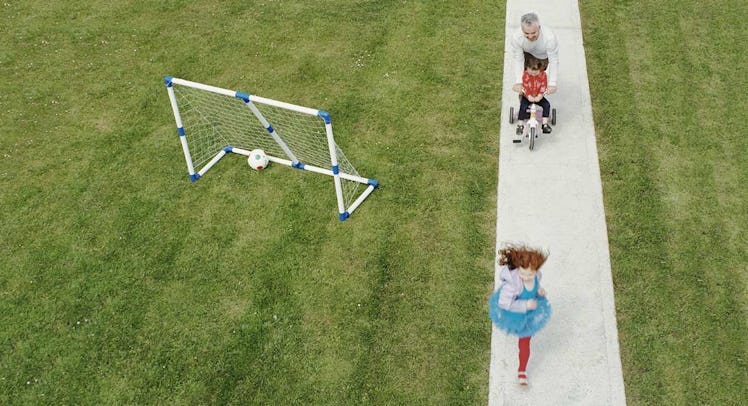Everything You Need To Know About Getting Your Toddler Outside
Do some bug squatting ASAP

As your kid gets older, the pull of the great outdoors may start to grow weaker in the face of indoor delights. By the time they’re teens, the promise of VR might just be fantastic enough to replace “outside” altogether. But, on the bright side, at least you won’t have to yell at anyone to get off your lawn.
Encouragingly, your toddler is basically built to thrive outside. Every skill they’re learning can be honed in the woods, as if they’re some kind of tiny, adorable John Rambo. So, check out the developmental benefits of outside play for your toddler and a few ideas of how to make the outdoors really count.
The Sad Reality
A recent study lead by the National Institute for Play (where it’s probably insanely hard to get any work done) put a fine point on how dire the situation is for kids getting outside. Their finding showed that some kids around the world get as little as an average of 30 minutes of outdoor time daily.
While that may be shocking, it’s not as shocking as the fact that even prisoners get more daily outdoor time on average than children. Convicted criminals in lock-up get at least 2 hours. Half of kids worldwide get only 1 hour.
The Benefits Of Toddler Outdoor Time
Obviously you know some of the benefits already: getting outside means movement. Movement means exercise. Exercise means a stronger, leaner kid who will probably be able to beat you up someday. But more specifically, outdoor play dovetails with toddler milestones in some extraordinary ways.
Right now your kid is learning to do some pretty important stuff with their body. Between 18 months and 2 years they should be able to do the following:
- Throw and kick a ball
- Run
- Squat
- Climb
- Push
- Pull
- Jump
While some of those skills could probably be worked on indoors, it’s clear that they are absolutely outdoor-geared abilities. Unless you really want to get a new TV, in which case, give the kid a baseball and let them have at it.
Making it count
Here are some outdoor activities to help you get these skills rolling.
Throwing And Kicking
A small soccer ball will work fine for both throwing and kicking. Find a soft, flat area, and start by modeling how to kick the ball with your own foot. Then encourage your kid to kick it to you over a small distance. Slowly back up to increase the force and effort of their kick.
Throwing can start out two handed. If you begin by rolling a ball back and forth and then slowly increase your distance, your kid will instinctively want to start hurling that sucker at your face.
Running
You might think a super soft, even surface is the best place for your kid to run outside. But studies show that kids develop a greater sense of balance and awareness of their body in space if the terrain is uneven. Everything in moderation, obviously. Don’t push their new abilities too drastically. You should expect some scrapes and bumps if you kid takes a header during a chase but don’t overreact. Try to laugh it off and have the cartoon character bandaids handy.
Squatting
The best tool for teaching squatting in the wild are the creepy crawlies that inhabit flowerbeds and dirt. So point out pill bugs and worms and crickets. When you see them bending over to get a better look, model how to bend the knees into a squatting position. Here’s wishing your knees good luck.
Climbing
Your kid will naturally want to get on top of small rocks and hills, but there’s nothing wrong with learning this skill on your local playground equipment. If you don’t want to deal with the hassle of other parents at the park, there is plenty of equipment you can install in your own backyard to get your monkey climbing with the best of them.
Pushing And Pulling
There are tons of indoor push and pull toys, but they might not weather well. So consider miniature versions of adult outdoor tools. Mini wheelbarrows and lawnmowers abound and bank on the fact that your kid wants to mimic you. Yeah, that’s also why they’re always scratching their butt.
Jumping
This is one of the more advanced skills that your kid will start getting into around 2-years-old. Encourage jumping by giving them small “barriers” to leap over. You can start with chalk lines on a sidewalk (or even just the cracks) and work your way to small twigs and eventually tall buildings with a single bound.
Cognitive Development
Right now your kid is working on language and following short simple instructions. You can work this explosion of brain power on an exploratory walk. You’ll want to have a constant chatter as you walk, pointing out colors, shapes, objects, and animals.
This works wonders to grow your kid’s vocabulary. Also, by making it interesting to follow directions like “look over here” and “follow me” and “please don’t eat that bug,” they are becoming better listeners and more socially aware.
But really, even if you don’t do any of this, your kid’s natural cognitive and physical skill progression would naturally meld with the outdoors. But only if you get them out. And remember, weather isn’t an excuse. How is your kid ever going to discover all the great words connected to a rain puddle if they never get into one? So invest in some good gear (but not the VR kind. It’s a bit too early for that).